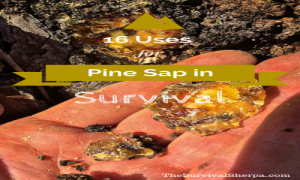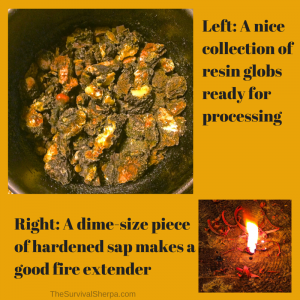Scavenging resources in a wilderness survival situation can turn up life-saving stuff. That’s why developing a possum mentality is vital!
Our ancestors walked our woodlands and learned to use the resources most modern outdoor enthusiast overlook. Essential woodland resources seem to be invisible to the modern eye. The stuff you’ve got packed in your woodcraft/bushcraft kit or bug out bag are consumable. You’ll eventually use up that roll of duct tape… or, more than likely, you forgot to pack it.
Not a problem. Pine trees produce a sticky substitute with superior benefits!
Learning to identify and use natural resources has gotten me out of many sticky situations in the woods. Pardon the play on words as we explore the many uses of this tacky, amber-colored pine sap I call Jewel of the Woods!
Collecting Sappy Jewels
Pine trees secrete resin as a defense to close wounds from insects or other forces. The sap provides a protective layer or sealant over the injury . The sap hardens forming an amber glob which turns dark in color over time. On fresh wounds, you’ll notice a whitish layer of sap covering the damaged area. With time, large clumps form making it easier to harvest.
Harvesting fresh resin can become a sticky situation. The fresher the glob, the more sticky and pliable. On dedicated Jewel of the Woods harvesting trips, I carry a grub knife, one I don’t mind getting covered with resin. To remove sap from my good blades in the woods, I use a bit of Everclear (190 proof) from my flask on a piece of cloth.
For hardened resin, poke a sharp object (grub knife or sharp stick) into the base of the glob and pry it loose. It’ll break off and fall into your hand or container underneath. That’s when you’ll notice the crystalized form inside which resembles a beautiful piece of amber stone.
For hard-to-reach spots high in trees, my friend Joe at Feral Woodcraftshares his clever resin harvesting tool.
Now that you’ve gathered a fair amount, what’s this sticky stuff good for?
A.) Self Aid
- Pine sap properties include: antiseptic, astringent, anti-inflammatory, antibacterial
- Treat wounds – apply it to cuts like you would super glue. Follow first-aid protocol for cleaning/flushing first.
- Stop bleeding – apply a soft glob (heat if necessary) to help stop bleeding.
- Treat skin rashes and eczema with ointments,tinctures, and salves. For tinctures, use 190 proof Everclear since resin won’t dissolve with watered down alcohols.
- Chew softer sap straight off the tree like a gum for sore throats and colds. You could pre-make “gum” with these ingredients: bees-wax, pine sap, and honey.
B.) Glue/Epoxy – Pine Pitch
- Turn pine resin into pitch sticks. Jamie Burleigh has a great tutorial of his method on Primitive Ways.
- Hafting arrowheads, fletching arrows and gluing other primitive tools and weapons.
- Waterproof boot seams, canoes, and containers.
- Patch holes in tents and tarps.
- Pretty much any thing you need to glue or patch in the woods, pine pitch is the product.
C.) Candling Device
- Place globs of dried resin in a fatwood torch to extend its burn time.
- Pitch sticks, described above, can be used as a makeshift candles.
- Melt sap and soak a cotton bandana or rag wrapped around a stick for a torch.
- Melted or liquid sap poured over a dried mullein stalk works as candle/torch.
D.) Fire Craft
- Fire is life in a wilderness survival scenario. Even on weekend camping trips, fire offers core temperature control, cooking, and hot cocoa! Resin is your secret weapon to starting and keeping a fire going in wet conditions. Anyone who’s used resin-rich fatwood in rainy conditions appreciates its important role in fire craft.
- Resin is highly flammable. Once lit, you can dry marginal tinder and small kindling.
- Harvest liquid sap into a container from a fresh cut in a pine tree to add to a makeshift torch. Secure the container under the exposed bark to collect the sap. Use this liquified sap as torch fuel.
Once you learn to identify this sticky life-saver, you’ll find it difficult to walk past a pine tree without scanning for this Jewel of the Woods!
Keep Doing the Stuff of Self-Reliance,
Todd
This article was originally published at Ready Nutrition™ on February 12th, 2015








